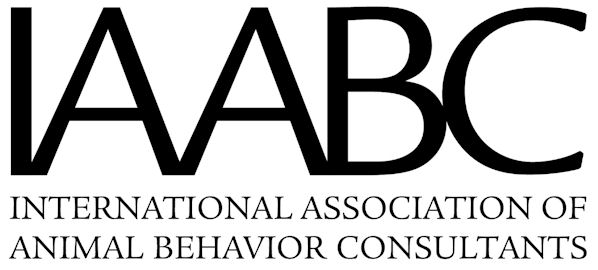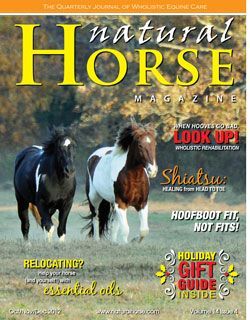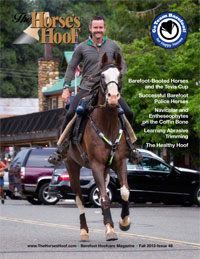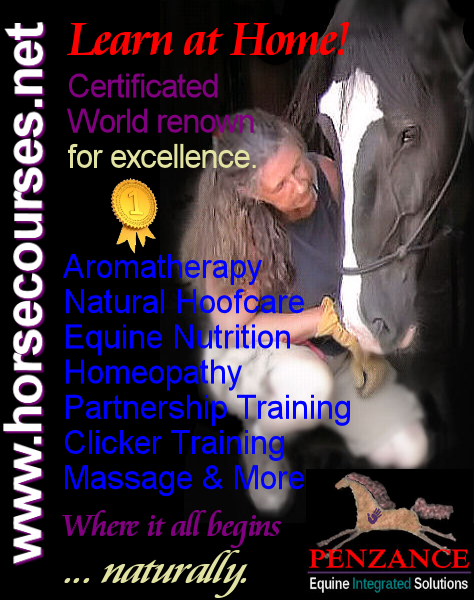Liberty Training I
Suzanne De Laurentis and Allen Pogue, Imagine A Horse © 2011
Liberty Training is a great way to spend quality educational time with any horse, and is especially useful to enhance the education of a young horse that is not yet physically mature enough to ride. Obedience, reliability, self-carriage and self-confidence are all increased with Liberty Training as the horse learns to respond to cues independently of a lead, or at liberty. The freedom of movement keeps the horses involved and energized in their work. Liberty Training can work to hone to perfection your horse’s response whether working at a distance or walking next to you.
At Imagine A Horse, the liberty patterns interspersed with tricks and behavior chains make for an intricate Circus-Style Act. The liberty movement between the tricks is like the silence between the notes that results in a musical melody. A Circus-Style Liberty Act is just turning up the volume on basic work and adding showmanship!
Liberty Training can aid in tasks as simple as your horse walking with you, un-tethered or as complex as a Circus Style Act but every aspect of it helps to create a bold yet obedient horse! The goal is to develop through Liberty schooling a horse that will stay with you and work with you reliably through mental attachment independently – without the mental security of a lead.
The (almost) Lost Art of the Square Pen
Long before Round Pens became popular, the square pen or corral was a staple of horse training. The corners of a square pen offer valuable training opportunities for sure as a horse can be taught to walk straight lines, stop, back, turn corners towards the handler and maneuver around obstacles, all at liberty.
In a Square Pen, no easy escape routes are available to the horse. By instilling habitual compliance a mental connection with the trainer can be called upon throughout the horse’s life and utilized in all training endeavors.
Square pen work should first be done only at a walk. Letting a horse zoom around either a round pen or square pen actually plays into a horse’s inherent nature of “flight” and does little or nothing to calm him or tire him. It is slow, thoughtful work which engages both the horse’s reactions and his mind that helps to create interaction, understanding and a mental attachment to the handler.
Liberty Schooling in a square pen requires thoughtful positioning of the handler’s body and utilization of the correct tools such as “Horse Friendly” guider whips. IAH Guiders are flexible whips with a soft snap and ball on the end that enables the handler to touch a horse for direction and not sting him.
In Liberty work we always use two whips, a guider to control direction and a lunge whip for movement or impulsion of the horse. Face the horse’s side at a distance of about 20 feet, with the short guider in the left hand, in a horizontal (neutral) position and the longer whip in the right hand and behind the horse’s rump.
Teach the horse to move forward in the square pen at a walk by flicking the lunge whip at his feet or rump, just as you would in a round pen but push him deep into the corners rather than letting him cut the corners when he.
Corners create the Halt
The first lesson in the halt on cue is to move the horse forward in a straight line along the wall or fence and as he reaches the corner, block his forward movement and use the corner as a barrier for him and ask him to halt or “whoa”. A horse will usually understand this method quickly because it is his natural inclination to halt in the corners. When he halts in the corner, let him have a few seconds of dwell time (release) as a reward and then direct him to “walk” again. Repeat this sequence in both directions until the horse will reliably halt when asked in each corner of the pen from either direction.
Inside Turns
It is disrespectful for any horse (or foal) to turn his back side toward the handler.
The corners of the square pen or corral offer a perfect place to instill the good habit of always turning toward the handler.
Ask the horse to move into the corner of the pen as when teaching the halt in the corners. Guide him into the corner with the whip at his rear but as he reaches the corner (barrier) take a step toward his head to block his movement and at the same time, reach with the shorter whip under the outer side of the his chin to capture the attention of his outside eye as you continue to ask him to walk forward. The action (and intention) is to encourage him to turn toward you as you block any other option. As he turns toward you and begins to walk off, praise him and take the pressure to move off of him temporarily by letting move at his own pace. Repeat this exercise in both directions until it is an automatic response for the horse to always turn toward you.
This is a very beneficial exercise as it teaches the horse to look at you with each eye separately and then both eyes (and both sides of his brain) as he faces you while turning. The practice of turning toward you helps him to develop agility with both sides of his body.
Our horses are handled in a constant state of Liberty Training. Instead of a physical attachment such as a lead rope or lunge line, we strive to create mental and emotional attachments through meaningful exercises. We like to say that foals raised in this manner are like kids that grow up in the circus-they think everyone can juggle or in this case, work at liberty.
As the horse becomes proficient at moving as directed in either direction, halting on cue, and making turns toward you and continuing on, increase the speed to a trot and include walk/trot transitions and turns in the corners.
Simple Patterns
If two pedestals are placed in the pen a few feet from the corner, the horse can be guided through a figure eight pattern around the pedestals. This is actually a half-turn around each pedestal with a cross over in the middle. As he becomes proficient at making the figure eight pattern he can also be taught to circle around a pedestal in each direction and to circle it two or three times as requested. To teach this, place a pedestal in the corner of the pen approximately 3 to 4 feet from the fence and begin to ask the horse to walk around or circle it as he comes out of a corner turn. Our horses respond to the verbal cue of “turn” for a simple or half-turn and “again” which means to complete the additional half of the circle all the way around the pedestal.
This simple set of patterns can become the foundation for a Circus-style Liberty Act or to simply increase the level of compliance that your horse will offer.
Working into Pressure
Corners of the square pen also can be used to teach a unique concept that we call “working into pressure”. This valuable technique is different than teaching a horse to physically move away from pressure as is the case in most horse training. Working into pressure enhances boldness while creating obedience; a great concept for a working or sport horse! The horse will learn to think and to comprehend your intention and then to act appropriately, not to merely react and run away.
The horse needs to know pedestal basics before moving to this exercise. After he has been taught to mount the pedestal (with at least the two front feet) place a pedestal in the corner of the pen at an angle and 5 to 6 feet from where the two sides meet. Ask the horse to trot into the corner and “turn” toward you. Motivate him to hustle and as he turns toward you, back up a step or two and ask him to Step Up on the pedestal facing you. Turning toward you and then stepping up must be presented to him as his only option and the only way that the pressure on him will be released. During the first few repetitions, if the horse doesn’t understand the request or is nervous, lead him to the pedestal and ask him to “step up” to demonstrate your request and then proceed.
Walk with me
It is both fun and functional to have a horse that will “walk with” you without a lead. Executing the halts, turns and simple patterns that he has learned will give him an incentive to “walk with” you. Offer praise or even a food treat as an added bonus to stay with you. Waking beside you slowly through patterns is a comfortable place for a horse to be; he has leadership, companionship AND it is easy. If he becomes detached from you, send him out to work at a quick pace for a few minutes before you ask him to come back and “walk with” you. Most horses will happily walk next to you rather than do laps in the pen!
At this time, when your horse comes to you rather than trotting the perimeter, it is a good time to introduce a verbal cue such as “come” or “here” followed by a food treat. The verbal cue of “here” can also be transferred to a whistle cue that can be used on the trail if you are accidentally separated from your horse.










